Physical Address
304 North Cardinal St.
Dorchester Center, MA 02124
Physical Address
304 North Cardinal St.
Dorchester Center, MA 02124
Circular Arrangement Questions are most asked question in GRE/CAT- MBA/ Banking / IBPS/ SBI exams. In these type of question you will be given a brief scenario of people seating in around circular table and with various relative positions. Based upon these Scenario you will be asked 4-5 questions to find out the position of specific person.
What is Circular Arrangement?
In this type of arrangement, we arrange people or objects around a circle or a table. In case of people sitting around a table, the table could be of any shape i.e. rectangular, square, circular etc.
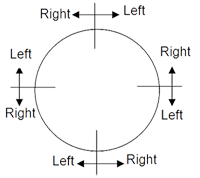
In the above arrangement, some persons are sitting around a circle and they are facing the centre. The diagram highlights the left and right of the people for this case.
How to solve Circular Arrangement question
Movements around the circular arrangement can be read as :
For the people facing the centre:
For people facing outside, the opposite is true:
What information is given in Questions brief
The information given in such questions specifies the position of a few or all the persons in the arrangement.
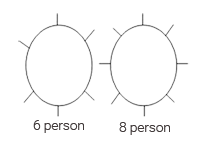 Remember, if you are careful of the directions, then this question should be a fairly easy one to solve.Seating Arrangement Solved QuestionGiven below is an example of a typical question of mixed directions (both, inside and outside).Example: A, B, C, D, E, F, G and H are sitting around a circular area at equal distances between each other, but not necessarily in the same order. Some of the people are facing the centre while some face outside (i.e. in a direction away from the centre)Note:Facing the same direction means if one faces the centre then other also faces the centre and vice versa. Facing opposite direction means if one person faces the centre then the other faces outside and vice versa.B faces outside. D sits second to the left of B. A and F are immediate neighbours of D. H sits second to the right of A. C sits third to the left of H. E sits to the immediate right of G. D sits third to the left of E. D faces the same direction as H. F sits to the immediate right of C. F and G take same directions. Find the desired arrangement.Solution: Let us try to solve this question clue by clue:
Remember, if you are careful of the directions, then this question should be a fairly easy one to solve.Seating Arrangement Solved QuestionGiven below is an example of a typical question of mixed directions (both, inside and outside).Example: A, B, C, D, E, F, G and H are sitting around a circular area at equal distances between each other, but not necessarily in the same order. Some of the people are facing the centre while some face outside (i.e. in a direction away from the centre)Note:Facing the same direction means if one faces the centre then other also faces the centre and vice versa. Facing opposite direction means if one person faces the centre then the other faces outside and vice versa.B faces outside. D sits second to the left of B. A and F are immediate neighbours of D. H sits second to the right of A. C sits third to the left of H. E sits to the immediate right of G. D sits third to the left of E. D faces the same direction as H. F sits to the immediate right of C. F and G take same directions. Find the desired arrangement.Solution: Let us try to solve this question clue by clue: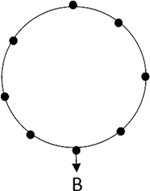 After fixing B’s position, we can see that D will be in anti-clockwise direction from B and since D is second to the left, this means there will be 1 person in between them. But we don’t know the direction of D yet, so D can be facing inside or outside.
After fixing B’s position, we can see that D will be in anti-clockwise direction from B and since D is second to the left, this means there will be 1 person in between them. But we don’t know the direction of D yet, so D can be facing inside or outside.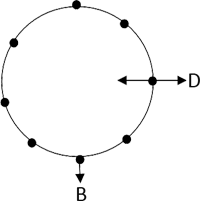
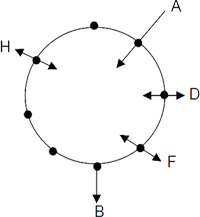 A could be between B and D while F could be on the other side of D. Again A could be facing outside or inside. Now in case we take A, facing inside, then 2nd to his right would be H whereas we know that this position belongs to F since it is A and F who are neighbours of D. So in this position we can take A to be facing only outside. We can also add H at 2nd clockwise to A and F at the other side of D. Directions, of F, D and H, are not clear yet, so they could be facing inside or outside.
A could be between B and D while F could be on the other side of D. Again A could be facing outside or inside. Now in case we take A, facing inside, then 2nd to his right would be H whereas we know that this position belongs to F since it is A and F who are neighbours of D. So in this position we can take A to be facing only outside. We can also add H at 2nd clockwise to A and F at the other side of D. Directions, of F, D and H, are not clear yet, so they could be facing inside or outside.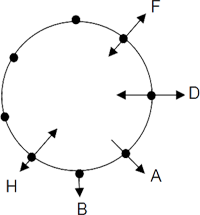
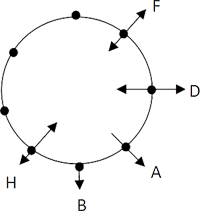
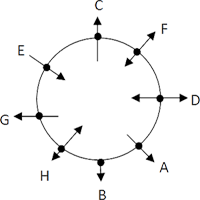
Seating Arrangement questions are tricky to solve. Practice as many questions as possible to gain an upper hand in Analytical Reasoning.
Practice Question for Circular Seating Arrangement
Direction (1 to 5 ): Study the following sitting arrangement carefully and answer the given questions.
Passage I
Eight friends, P, Q, R, S, T, V, W and Y are sitting around a square table in such a way that four of them sit at four corners of the square while four sit it in the middle of each of four sides. The one who sit at four corners faces the centre while those who sit in the middle of the sides faces outside. P who faces the Centre sits third to the right of V. T, who faces Centre, is not an immediate neighbour of V. Only one person sits between V and W. S sits second to the right of Q. Q faces the centre. R is not an immediate neighbour of P.
1. Which of the following statement is true regarding R?
2. What is the position of T with respect to V.
3. Who sits second to the left of Q?
4. Who sits third to the left of V?
5. Four of the following five are alike in a certain way based on the above arrangement and so form a group. Which is the one that does not belong to that group?
Direction (6-10) Study the following sitting arrangement carefully and answer the given questions.
P, Q, R, S , T, U, V and W are sitting around the circle and are facing the centre. P is second to the right of T who is neighbour of R and V. S is not the neighbour of P. V is the neighbour of U. W is sitting between S and U.
6. Who is an immediate right of V?
7. Which of the following statement is correct?
8. Which two of the following are not neighbours?
9. Who is the immediate neighbour of S?
10. What is the position of S?
Directions (1-5): Circular arrangement puzzle based questions:
Circular Arrangement problems are a type of seating arrangement problems in which some people are sitting around a circular table either facing the centre or facing away from the centre. It is an important topic as you can expect 5 questions from this topic in Pre & Mains exams.
Here, in this article we are providing you 2 set of questions 5 questions each:
P, Q, R, S, T, U, V and W are eight individuals sitting around a circular table facing the centre.
P is second to the right of T who is the neighbour of R and V.
S is not the neighbour of P.
V is the neighbour of U.
Q is not between S and W.
W is not between U and S.
(a) RV
(b) UV
(c) RP
(d) QW
(e) None of these
(a) P
(b) U
(c) R
(d) T
(e) None of these
(a) P is to the immediate right of Q
(b) R is between U and V
(c) Q is to the immediate left of W
(d) U is between W and S
(e) None of these
(a) Between U and V
(b) Second to the right of P
(c) To the immediate right of W
(d) Data inadequate
(e) None of these
(a) Q
(b) W
(c) S
(d) U
(e) V
Step 1:

P is second to the right of T who is the neighbour of R and V.
Step 2:

S is not the neighbour of P.
V is the neighbour of U.
Step 3:

Q is not between S and W.
W is not between U and S.
Answer